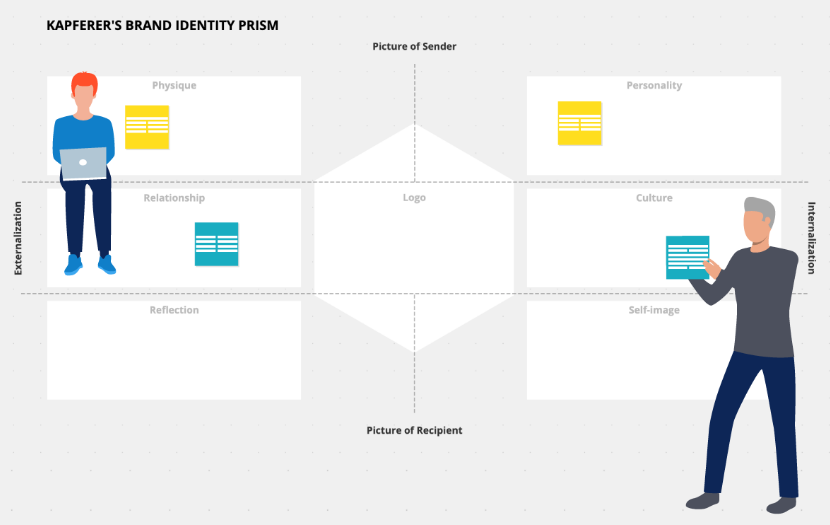The Brand Identity Prism was conceptualized by branding expert Jean-Noël Kapferer. The prism works are a way to show how different elements of the brand work together and relate to each other. Under his theory, the prism can be used to visualized and help businesses build strong brands. It acts as a guide to communicating the brand identity in ways that are memorable and focus marketers on the way the consumer would perceive the brand.
“Strong brands are capable of weaving all aspects into an effective whole in order to create a concise, clear, and appealing brand identity,” said Kapferer.
Elements of the Brand Identity Prism
The Brand Identity Prism is made up of six key elements (attributes):
- Physique
- Personality
- Culture
- Relationship
- Self-image
- Reflection

Image Source: Concept Board
The prism considers how each of these elements is viewed in relation to the sender and the recipient and are divided into externalized and internalized aspects.
Externalization
- Physique
- Relationship
- Reflection
Internalization
- Personality
- Culture
- Self-Image
The beauty of the prism, though, is how it takes external concepts and relates them to how the target consumer would internalize them. It goes across the prism from theories to perception and works in pairs.
Physique & Personality
Physique refers to physical attributes associated with the brand. Think of it as a set of adjectives and external characteristics that define the brand. Levi’s physical attributes would be the red Levi’s logo and the classic blue jeans themselves. Coca-Cola’s physique would be the unique shape of the coke bottle, the Coca-Cola logo, and the red and white design.
These represent visual cues to help with recognition and association. Apple, for example, sees their physique as the Apple logo, an attention to detail, and thinking differently.
Personality is the character of the brand and is often expressed as assigning human characteristics to the brand. In other words, what do marketers want you to feel when you see the physical aspects. For Coke, it translates to sharing, refreshing, or happiness. For Levi’s, it might be youthfulness or rebelliousness.
These are the traits of the brand as seen through the lens of the customer. Apple users see the products as cool, beautifully-designed, and easy to use.
Relationship & Culture
Relationship, as Kapferer sees it, is the way a brand attempts to connect with consumers or how consumers develop a relationship with a brand. Coca-Cola defines its relationship as more than just a drink in a bottle. Levi’s relationship might be based on customers who share like situations and adventures.
A company like Ralph Lauren might describe the relationship they want with customers as exclusive and distinctive.
Culture defines the value system and principles on which the brand bases its behavior. The most successful brands translate culture into a common human theme. For Levi’s, it’s a proud American company that celebrates individualism. Coca-Cola defines its culture as sharing good times, socializing with friends, and being a part of traditions.
Culture is how it translates into an emotion or attitude. For Ralph Lauren, that exclusive relationship sends a signal of American luxury.
Reflection & Self-Image
Reflection represents the ideal vision of the brand to customers and reflects the way the company wants its customers to identify with the brand. Levi’s projects an image of youthful trendsetters without having to try too hard to impress their friends. For Coke, it’s about youth, fun, and good times.
Reflection is how the brand perceives the way they want their brand to be seen. Dove might define its brand reflection as appealing to a natural and confident modern woman.
Self-Image comes from the way consumers use the brand’s products. What might be termed the final confirmation of the brand, it’s the image consumers have of themselves when using the products. For Coke, it can be summed up as a social event with friends and family. For Levi’s, it’s independent and confident.
The ideal situation would be for consumers to want to associate themselves with a brand. Dove’s would want to see its customers to view themselves as confident, beautiful, and inspired.
Communicating Brand Identity
Working together, these six aspects of The Brand Identity Prism can help develop internal and external ways to communicate brand identity. It works as a way for brands to identify and transmit specific imagery to its customers.
Kapferer believes this imagery and the emotions it evokes is the key to building lasting brands.
Other Classic Frameworks:
If you liked The Brand Identity Prism, please read about other classic frameworks by other famous authors:

